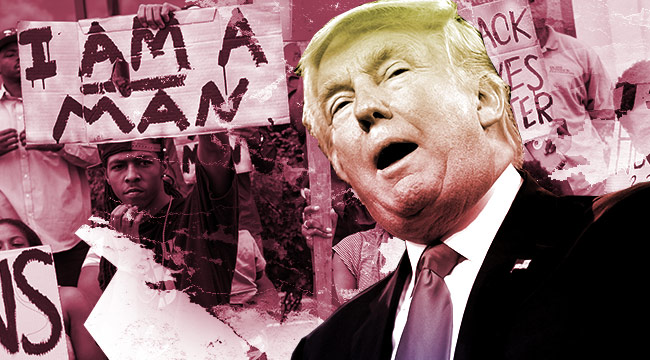
Late last week, Donald Trump performed his second major campaign staff overhaul with approximately 80 days remaining until the general election. The real estate mogul is now apparently making an effort to appeal to minority voters with a plan to meet with black activists at Trump Tower. The purpose of this meeting is to gather recruits — from both the African-American and Latino communities — to be field operatives for the Trump campaign. Presumably, outreach is the main goal, but a campaign source tells Yahoo News that “the initiative is not solely focused on training minority activists.”
Trump’s team is also organizing voyages to urban areas that he’s normally eschewed in favor of predominantly white suburbia. His Wednesday night rally will be held in Jackson, Miss., which has a predominantly black population that runs close to 80 percent. Another trip under consideration is “a tour of impoverished neighborhoods” in Detroit with his own personal guide, former rival and neurosurgeon, Ben Carson.
Will Trump be successful in this outreach? His VP candidate, Mike Pence, couldn’t hold back a hearty chuckle over Trump’s overly optimistic predictions of eventually scoring support from 95 percent of black voters. And at times like these, it’s probably worth remembering that Trump’s history with “The Blacks” is, well, not so great.
- In 1973 (and as Clinton VP pick Tim Kaine recently reminded voters), the Justice Department filed a massive lawsuit after Trump and his father discriminated against black people who tried to rent apartments in their buildings. Folks would show up to tour vacant rental spaces only to be turned away, and it was not a good look. The Trump Management Corporation settled the suit and agreed to no longer discriminate against black people or other minorities.
- In 1989, Trump railed against the Central Park Five — a group of black and Hispanic teenagers who were convicted of the brutal beating and rape (and near homicide) of a young woman — by spending $85,000 on full-page ads in New York newspapers, including The New York Times and New York Post. The ad copy contained 600 words and was titled, “Bring Back the Death Penalty. Bring Back Our Police!” Some critics felt that Trump’s ads “colored the eyes of prospective jurors who ultimately sat on the case.” The group was later exonerated when another man confessed to the crime, and DNA evidence supported his claim.
- In April 2014, Trump doubled down on the infamous Central Park Five ad after the city of New York paid the exonerated defendants $41 million in damages. In a New York Daily News op-ed, Trump reacted to the settlement as a “disgrace” and the “heist of the century.” He then angrily tweeted that the group certainly wasn’t “playing checkers” while the victim was attacked while jogging in the park.
- John O’Donnell, the former president of Trump Plaza Hotel and Casino, wrote in a memoir how Trump was disgusted by “black guys counting my money” and would actually prefer to use “short guys that wear yarmulkes every day.” O’Donnell also wrote that Trump believed, “Laziness is a trait in blacks.” He reportedly added, “It’s not anything they can control.”
- In April 2011, Trump visited a radio show to talk about his political dreams. He described Barack Obama’s high poll ratings among black voters as “troubling,” and he also described Hillary Clinton’s comparatively low numbers as “proof” that he would also not fare well in a presidential bid. Trump described this as a “very sad thing” because, as he claimed, “I have a great relationship with the blacks. I’ve always had a great relationship with the blacks.”
- In June 2016, Trump bizarrely paused a rally in Redding, Calif. to discuss a black Trump supporter from a previous rally, who had “cold-cocked” a protester who was wearing a KKK hood. Trump raved about this “fan of mine” and mused about missing this “great guy”: “In fact, I want to find out what’s going on with him.” At that point, he saw a different black man in the audience and proudly raved, “Look at my African-American over here. Look at him!”
- In August 2016, Trump took the podium in Dimondale, Mich. and asked black voters, “What do you have to lose?” Trump explained his version of the truth, which was that this minority community must be so downtrodden and hopeless that only Trump could heal their suffering. The real estate mogul then issued a wild “guarantee” that he would nab “95 percent of the African-American vote” during his (hypothetical) 2020 reelection bid.
Trump’s attempts at outreach raise suspicion by some who question his motives. Does Trump truly believe he can win over a minority community after not only insulting black voters but Muslims and Hispanics as well? Perhaps this is simply a show for his existing voter base. Regardless of whether or not these mysterious tactics will work, Trump’s fourth-place polling position among black voters doesn’t appear to be deterring him.

